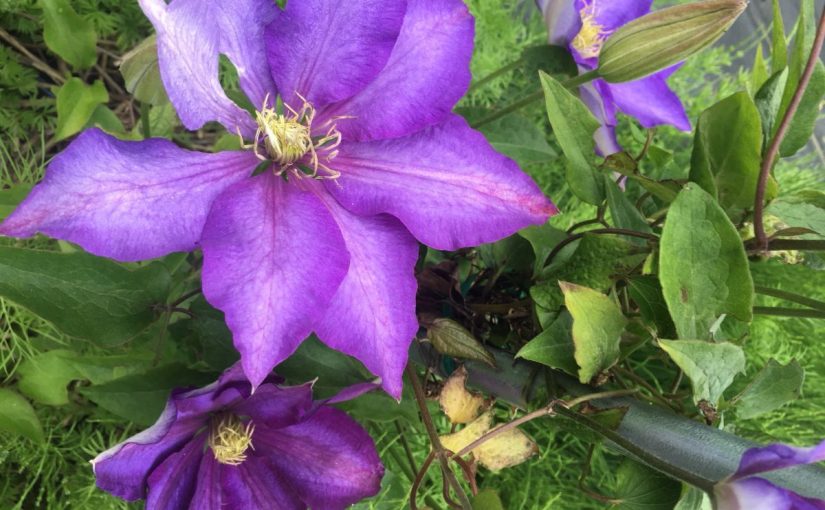Family: Ranunculaceae (also in this family: buttercup, ranunculus, anemone, nigella, delphinium, hellebore, columbine). Members of the family are primarily herbaceous perennials, but a few are woody climbers or shrubs. For the most part, flowers in this family will be bisexual. Flowers may be solitary, but are often clustered in cymes, panicles, or spikes. The flowers are typically radially symmetrical but are strongly bilaterally symmetrical in the genera Aconitum and Delphinium (Zomlefer).
Subfamily: Ranunculoideae
Tribe: Anemoneae
Genus: Clematis (over 300 species in this genus!)
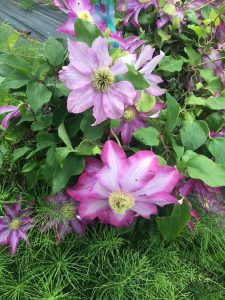
Photo: Allie Kuppenbender
The Clematis genus clearly has a wide variety of species comprised predominantly of vigorously climbing vines and lianas. They are found primarily in temperate regions of the Northern Hemisphere. Species native to cooler temperate regions are generally deciduous while species native to warmer regions tend to be evergreen (Jello Mold Farm).
Trellising clematis properly is crucial to being able to use it as a cut flower. Without a way to grow upward, the stems will become a snarled mess. The vines will wrap around each other rather than upward, making it impossible to untangle and use the flowers. Trellising requires weekly tying up of new growth to ensure upward growth.
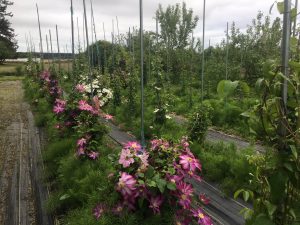
Photo: Allie Kuppenbender
According to Michigan State University, “Clematis grow and bloom much better if they have a dormant period of approximately six weeks. Night temperatures of about 45°F (7.5°C) or colder for a week or more seems to put them into dormancy. Gardeners should be aware that most of the excellent books on Clematis originate in England, where climatic conditions are quite different from those in most of North America” (An Introduction to Clematis).
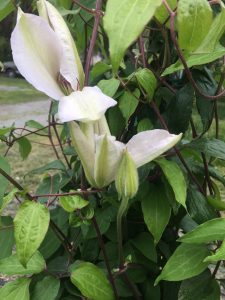
Photo: Allie Kuppenbender
According to Michigan State University and Jello Mold Farm:
- Zone: 4-9
- Bloom Time: variety dependent; some late spring others summer others yet fall
- Bloom Size: 1-10in (variety dependent)
- Height/Spread: 6-30ft (variety dependent)/spread variable based upon purpose; as a cut flower, want it to grow upward as much as possible
- Soil: moist, well draining with a neutral to slightly alkaline pH
- Site: most varieties require at least a half day of sun or strong filtered light to bloom well but will want shade for the hottest part of the day in warmer climates
- Type: Woody vine
- Seed Type: Dicotyledon
Clematis needs to be properly trellised and maintained to have harvestable stems, which takes a lot of time and labor. If you’re willing to make the investment, the return can be worth it. Jello Mold Farm can sell bunches of 5 for $25/bunch at the Seattle Wholesale Growers Market. Harvesting clematis can be a bit of a puzzle. Find a harvestable bud and follow the stem as far back as possible through the tangle of other stems. Cut when it can no longer be followed. You want to choose buds that are just beginning to open. Can also harvest seed pods after the petals have fallen off.
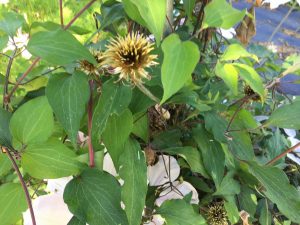
Photo: Allie Kuppenbender
SOURCES:
Jello Mold Farm (Mount Vernon, WA)
An Introduction to Clematis, Michigan State University
Guide to Flowering Plant Families, Wendy B. Zomlefer
Plant Families: A Guide for Gardeners and Botanists, Ross Bayton and Simon Maughan
Specialty Cut Flowers; The Production of Annuals, Perennials, Bulbs, and Woody Plants for Fresh and Dried Cut Flowers, Allan M. Armitage and Judy M. Laushman
